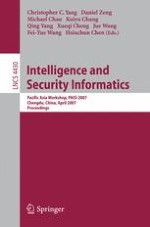Intelligence and security informatics (ISI) is concerned with the study of the development and use of advanced information technologies and systems for national, international, and societal security-related applications. The annual IEEE International Conference series on ISI was started in 2003 and the first four meetings were held in the United States. In 2006, the Workshop on ISI (http://isi. se. cuhk. edu. hk/2006/) was held in Singapore in conjunction with the Pacific Asia Conference on Knowledge Discovery and Data Mining, with over 100 contributors and participants from all over the world. These past ISI conferences have brought together academic researchers, law enforcement and intelligence experts, information technology consultants, and practitioners to discuss their research and practice related to various ISI topics including ISI data management, data and text mining for ISI applications, terrorism informatics, deception and intent detection, terrorist and criminal social network analysis, public health and bio-security, crime analysis, cyber-infrastructure protection, transportation infrastructure security, policy studies and evaluation, and information assurance, among others. We continued this stream of ISI conferences by organizing the 2007 Pacific Asia Workshop on ISI (PAISI 2007) to especially provide a stimulating forum for ISI researchers in Pacific Asia and other regions of the world to exchange ideas and report research progress. PAISI 2007 was hosted by the Chinese Academy of Sciences, the University of Arizona, and the Chinese University of Hong Kong.
